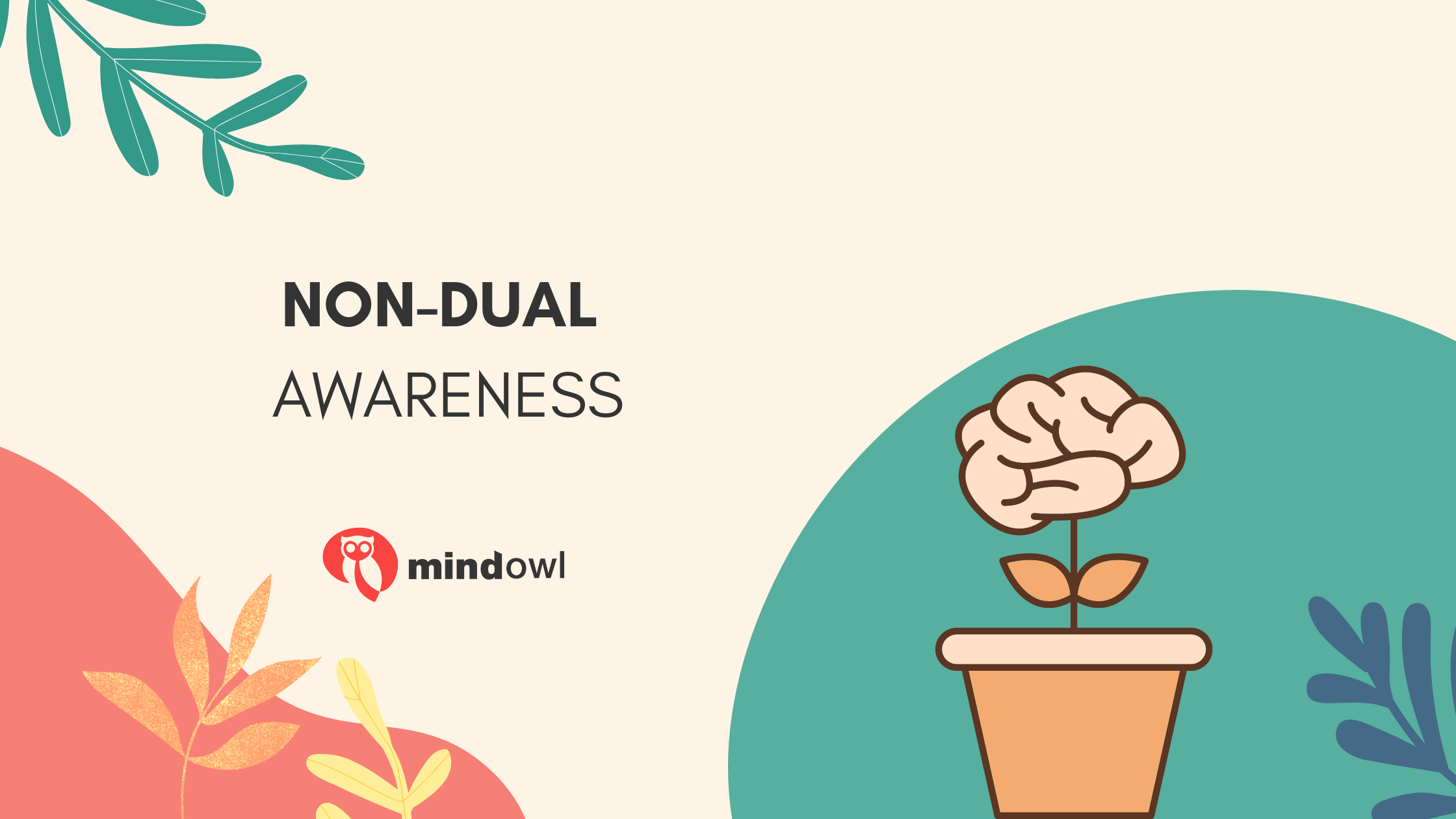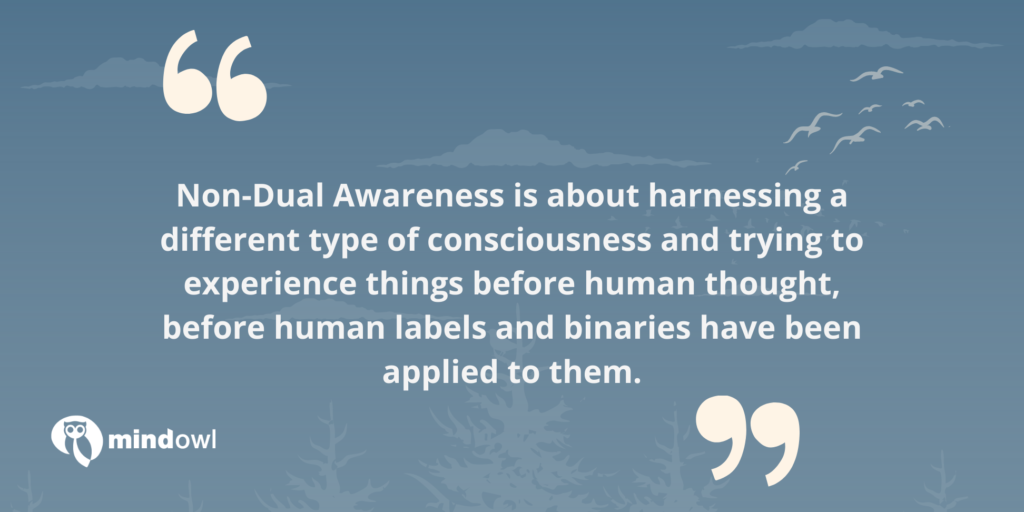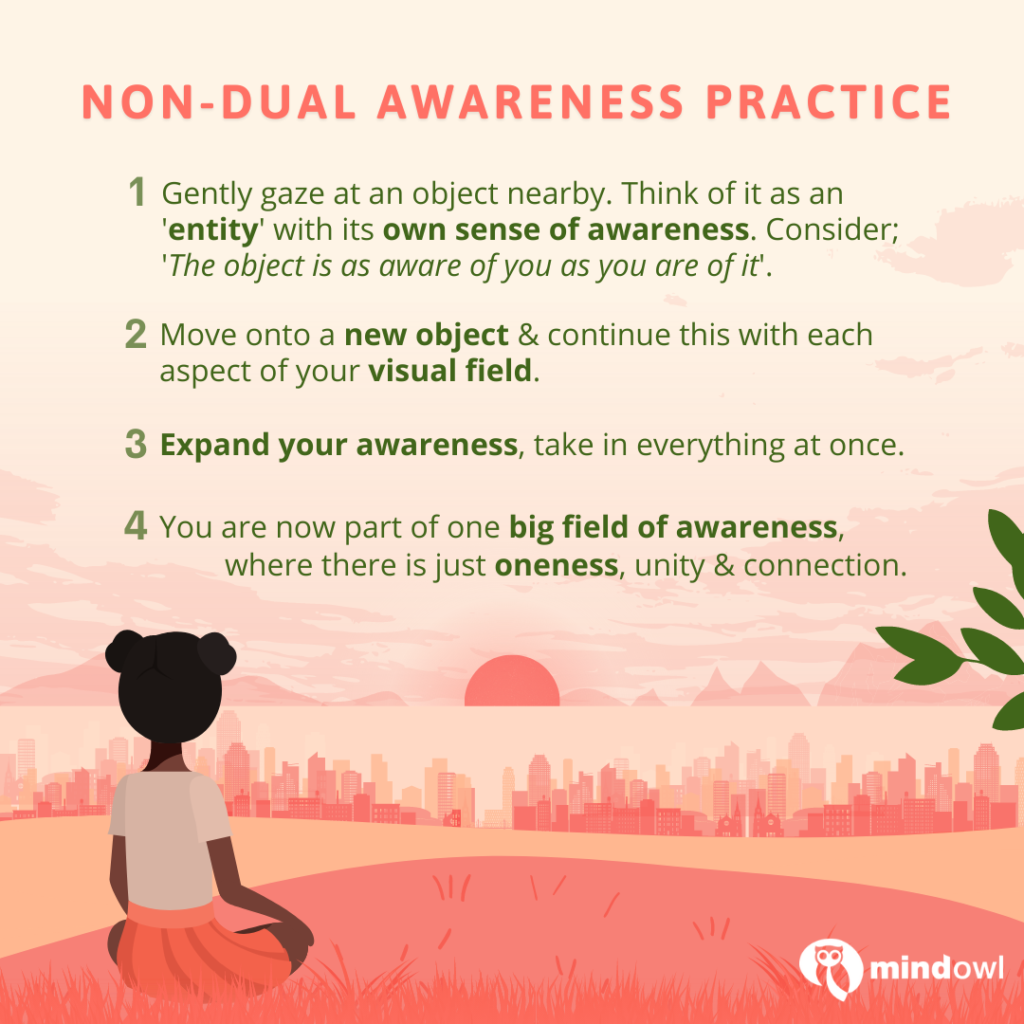Meditation is guided by a deep interest in human awareness. While people start meditating for a number of reasons, one of the biggest motivations is the possibility of unlocking the subconscious mind and expanding our sense of perception. If that’s an ambition of yours, one of the best tools available to you is Non-Dual Awareness.
When you begin practising meditation and finding out more about the subject, it’s likely that you’ll come across terms like “oneness” or “non-duality”. The idea of being “at one with everything” has been expressed across all of the world’s major meditative traditions, whether it’s Advaita Vedanta, Sufism, Buddhism or Kabbalah. But what does this concept actually mean? And how can we benefit from practising Non-Dual Awareness?
Before we get started, it’s worth noting that this can be a hard concept to grasp at first. Over the course of today’s article, we’ll provide a detailed summary of the history, development and practical application of Non-Dual Awareness. Let’s get into it.
What Is Non-Duality?
Non-Duality is a slippery concept with many different spiritual and secular associations. Put simply, it’s a state of consciousness in which practitioners feel as though they’re an essential part of their surroundings.
American spiritual teacher Shinzen Young describes Non-Dual Awareness as “an experience of oneness between subject and object”. Others have defined it as an experience of intimacy with all things, the feeling of identifying with the entire universe. It might sound strange, but in practice this means feeling as though rather than being a witness, you are the things you are beholding. Whether it’s birdsong, a mountain, or a lake, you feel like you become the object, and the separation between the seer and the seen disappears.
In order to understand what Non-Duality is, it can be useful to consider what ‘duality’ is. At the ordinary level of consciousness, everything that comes into our awareness appears as a duality. Every concept we have is defined against its opposite: man/woman, wet/dry, happy/unhappy — everything we are able to interpret can be defined in comparison to its opposite. Non-Dual Awareness seeks to break down this assumption.
Just like many other forms of meditation, Non-Duality seeks to shift practitioners’ perception away from the ego’s self-identification and towards self-realisation. Essentially, this means that by realising our own patterns of misperception and understanding that our lives are built on assumptions, we can experience a kind of ‘awakening’. It’s human nature to become attached to assumptions about the world which often aren’t true, so unfortunately this process can be difficult. Non-Duality seeks to make this mode of thinking come a little more naturally.
Where Did Nonduality Come From?
Non-Duality encompasses hundreds of techniques that have been developed in every corner of the globe. Arguably, its lack of connection to any particular religious tradition makes it more accessible to anyone — advocates of the practice say that Non-Dual awareness is an essentially human experience which lies at the root of all human awareness.
While the Nondual experience has ties to various regions, the practice’s roots are planted most firmly in the Indian subcontinent and its major religions.
Hinduism and Buddhism both have concepts of Non-Duality at the heart of their belief systems. In Hindu contexts, Non-Duality is called advaita, or advaita vedanta. This literally translates as “not-two-ness”, and is the source of the English term. While Hindu advaita is rooted in spirituality, involving a sense of oneness and identity with God, the Indian Buddhist tradition of Non-Duality – called no-self (anatta), emptiness (shunyata), or rigpa – is not a deity-based practice.
Elsewhere, some Zen Buddhist lineages call this state ryomou, with ‘Ryo’ meaning ‘both’ and ‘mou’ meaning ‘disappeared’. This translation encapsulates the idea of both the subject and object literally disappearing into one thing as they unite. Again, by harnessing this type of awareness, the practice seeks to shine a light on the true nature of human experience.
Regardless of the differences we’ve touched on, all these traditional practices rest on the belief that we are already completely, perfectly enlightened. The idea is that some form of practice must be adopted in order to tease this true nature out of ourselves. Non-Dual Awareness is about harnessing a different type of consciousness and trying to experience things before human thought, before human labels and binaries have been applied to them. By doing this, we can realise that everything is made of the same materials, therefore not everything is as distinct as we might initially think. You can find out more about the spiritual roots of non dual awareness here.
Is There Any Science Behind Non-Dual Awareness?
Okay, so we’ve looked a little at whereabouts Non-Duality came from; but what about where it is now? Much like meditation, many people use this technique as a way of experiencing some kind of awakening or ‘enlightenment’, even if their practice isn’t necessarily guided by a religious search for ‘salvation’.
Advocates of Non-Dual Awareness often talk about this state of consciousness as some kind of ‘ultimate reality’, or ‘absolute reality’. But what does that mean? And is there any science or data to back up the reported effects of Non-Dual Awareness?
One study by psychologist and neuroscientist Zoran Josipovic showed that during non-dual awareness practices, meditators were simultaneously aware of their internal and external experience, without intrinsic and extrinsic brain networks competing with each other. He argues that non-duality is everywhere, we just have to notice it. In fact, according to Josipovic our brains are actually organised in a way that encourages non-duality. Practising Non-Dual Awareness encourages neuroplasticity and thereby leads to mental freedom.
Despite Josipovic’s work, it’s important to note that any assertion made about a kind of ‘ultimate reality’ is inherently untestable. There’s no way of proving that Non-Dual Awareness helps practitioners experience ‘the ultimate reality’; however, if this practice gives you a powerful, spiritual, or even transformational experience of oneness with the things around you, does it matter how much scientific data there is to back it up?
Ultimately, the outside world is only ever experienced through consciousness. Our eyes convert visual fields into electrical signals, which the brain then processes and assembles into a mental image of the outside world. This means we’re never really seeing the outside world, we’re just seeing a constructed mental representation of it. In a way, this proves one of the foundations of the Nondual experience: the fact that ‘the entire world is consciousness’. There might not be any scientific proof for Non-Duality, but this is a fairly good explanation for what it entails.
Non-Dual Awareness vs Mindfulness Meditation
Now that you’ve got a better idea of what Non-Dual Awareness encompasses, you might be wondering about its relationship with mindfulness and other meditative practices.
The truth is, as disciplines, Non-Duality and Mindfulness have often butted heads. While mindfulness meditation can often come across as an effortful practice concerned with reaching enlightenment, Non-Dualists tend to argue that we are already enlightened. Modern practitioners of Non-Dual Awareness, which is sometimes called ‘neo-advaita’, argue that the more you struggle to be free, the more you ignore the freedom that is already there. For this reason, mindfulness practice is sometimes seen as unnecessary effort.
The problem with this way of thinking is that it fails to realise that Non-Dualism is more of a philosophy than a practical technique. It also fails to acknowledge that Non-Dual Awareness is a highly subjective experience that works differently for different people. Simply thinking that you are ‘free’ won’t stop you from experiencing tough things like financial hardship, family trauma, or relationship break-ups; however, mindfulness can be used to help you cope with such situations.
Rather than being diametrically opposed, these two traditions are in fact just on different ends of the same spectrum — the idea of how to inspire real freedom. In addition, there are certain forms of mindfulness meditation that are particularly useful when related to Non-Dual Awareness.
Self-enquiry practices, for instance, can expand our sense of consciousness by encouraging us to investigate the nature of the self and deconstruct that sense of self into its components. Asking yourself questions like “Who am I?”, “What is my experience of being?”, or “What is this ‘I’ that I attach to everything?” is designed to investigate your relationship with your experiences. This kind of self-interrogation can help reduce the distance between you and the world around you, which ultimately remains the goal of many forms of meditation. Another discipline built on this idea is Neti Neti Meditation (change to live article link), which encourages stillness and peace of mind by asking practitioners to withdraw their attention from all the disturbances around them.
How To Practise Non-Dual Awareness
We’ve explained how advocates believe that the state of Non-Dual Awareness is always there, always readily available. Because of this, it has been described as a kind of effortless meditation. However, this doesn’t mean there won’t be psychological blockages, layers of belief, or moments of ignorance that may get in the way of this experience. If you want to find out more about the subject of effortless meditation, check out our article here.
Now, it’s time to take a look at how Non-Dual Awareness works in practice. If you’re still slightly confused about what this method consists of, the following exercise should give you a better idea of how a direct experience of Non-Duality works. Let’s get started.
- First, get settled into a comfortable position. Breathe normally and spend a few moments just letting yourself relax slightly.
- Gently gaze at an object nearby. Try to maintain a soft gaze, taking the object in and thinking of it as an ‘entity’ with its own sense of awareness. Consider the idea that the object is as aware of you as you are of it.
- Move on to a new object. Again, notice that this object is shining with awareness, and that it’s noticing you while you’re noticing it.
- Repeat this practice for a third object, and continue doing this with each aspect of your visual field.
- Then, try to expand your awareness so that you’re taking in everything at once. Taking in this massive field of awareness is sometimes described as open attention. Think of this visual field as looking back at you, and try to connect and be at one with these surroundings.
- Note that you are now part of one big field of awareness. Here, there are no separations or binaries, there is just oneness, unity, and connection.
- Take some deep breaths and consider this idea of oneness for as long as you like. When you’re ready, you can end this meditation session.
Hopefully, this guided meditation will give you a better idea of what non dual awareness involves. It may sound like a complex practice at times, but in reality it’s a relatively simple process based on the idea of expanding your awareness of the things around you until you can include yourself as part of those surroundings. Immersing yourself in your environment in this way can help enrich your daily experiences and increase your peace of mind and sense of connection with the world.
There are a number of other practices you can use to help improve your natural awareness and reduce your sense of separation from the world around you. Exercises such as Open Attention or Beginner’s Mind can help you acclimatise to this new way of thinking and integrate it into your daily habits. You don’t always have to provoke some religious experience, or unlock the true nature of existence — but if it helps you achieve a freer, more relaxed, more curious nature of mind, what’s the harm in it? If you’d like more guidance on how techniques such as Non-Dual Awareness can impact your life in a positive way, join our meditation community and continue expanding your mind.
MindOwl Founder – My own struggles in life have led me to this path of understanding the human condition. I graduated with a bachelor’s degree in philosophy before completing a master’s degree in psychology at Regent’s University London. I then completed a postgraduate diploma in philosophical counselling before being trained in ACT (Acceptance and commitment therapy).
I’ve spent the last eight years studying the encounter of meditative practices with modern psychology.




